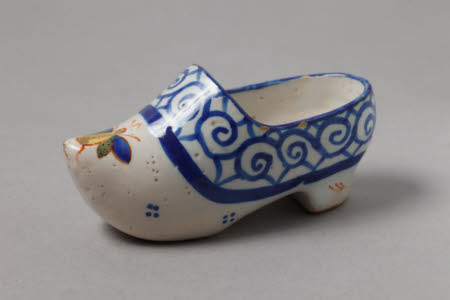Clog
Henriot Quimper
Category
Ceramics
Date
1904 - 1914
Materials
tin-glazed earthenware, hand coloured with enamels
Measurements
90 mm (Length)
Place of origin
Brittany
Order this imageCollection
Hill Top, Cumbria
NT 641552
Summary
Miniature clog, faience (tin-glazed earthenware), red terracotta body, Henriot Faïencerie, Quimper, France, ca 1904-14; the clog decorated with a scrolling repeating pattern beneath the rim, with a stylised butterfly in yellow, green and blue to the toe, groups of four small dots in blue around the body, blue edge to rim.
Full description
This miniature clog is part of the collection at Hill Top. Beatrix Potter purchased this farmhouse in the Lake District village of Near Sawrey in 1905, using the profits from her books. After her marriage to William Heelis in 1913, Beatrix relocated permanently to Sawrey. The couple made nearby Castle Cottage their home, but Beatrix spent as much time as she could at Hill Top. As well as a space for work and creativity – and the location for many of her famous tales – it became an intensely personal sanctuary for her. Beatrix knew exactly how she would decorate Hill Top and she arranged its interiors carefully and deliberately. She wrote: ‘I would have old furniture…it is not as expensive as modern furniture, and incomparably handsomer…’ Once she had renovated the farmhouse, she filled it with examples of local furniture and treasured heirlooms, like her grandmother’s warming pan and a set of plates decorated with designs by her father. The 1914 inventory of Beatrix’s family home, Bolton Gardens, South Kensington, lists ‘Bretaigne ware and Amphora, decorated fleur-de-lys etc. in blue’ in the Drawing Room, which might refer to this object and other pieces of Quimper pottery now at Hill Top. The clog was made at the Henriot Faïencerie in Quimper, Brittany. It was one of several potteries in the town making tin-glazed earthenware decorated in a distinctive local style, often depicting men and women in traditional Breton dress. Henriot made a wide range of pots, including small objects sold as souvenirs or sometimes as containers for serving salt at the table. The object is recorded as having moved from Troutbeck Park, so might have been used to furnish Beatrix’s study at the property.
Provenance
From Troutbeck Park.
Marks and inscriptions
JB (on base)
Makers and roles
Henriot Quimper, manufacturer
